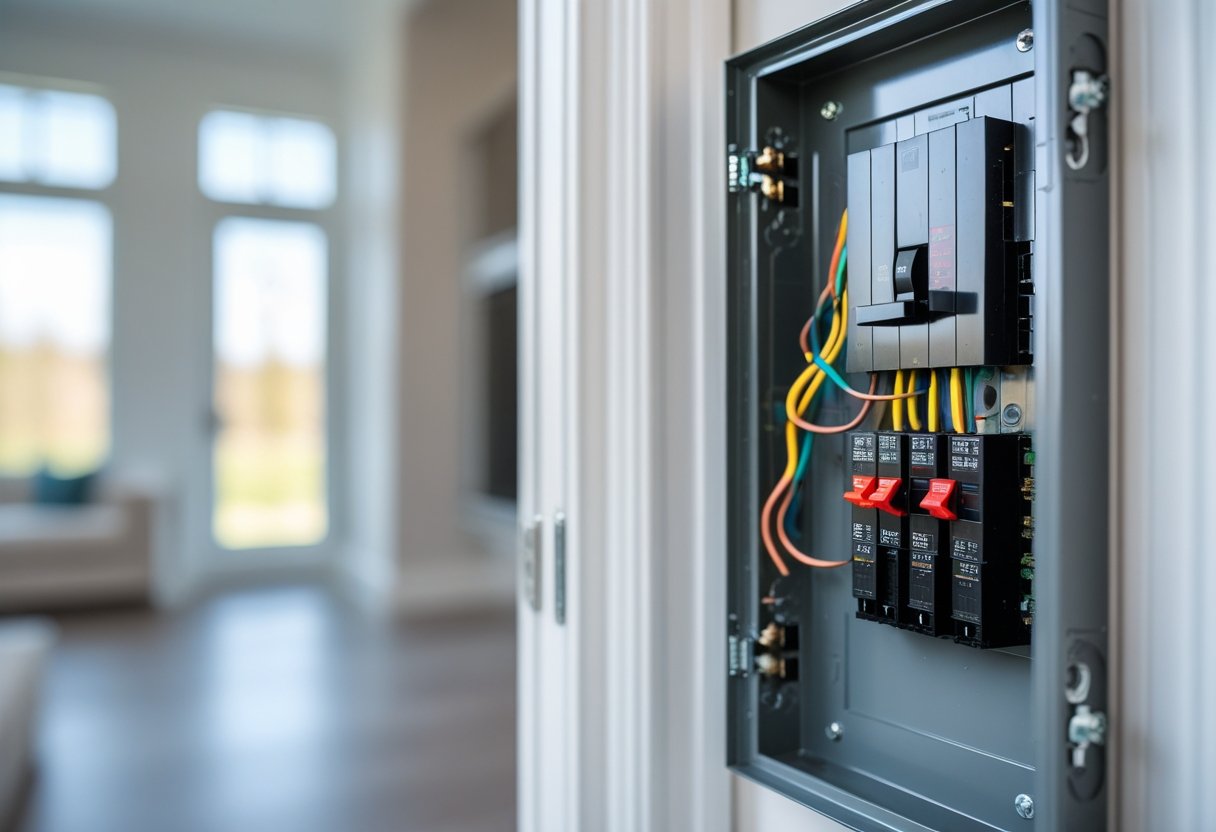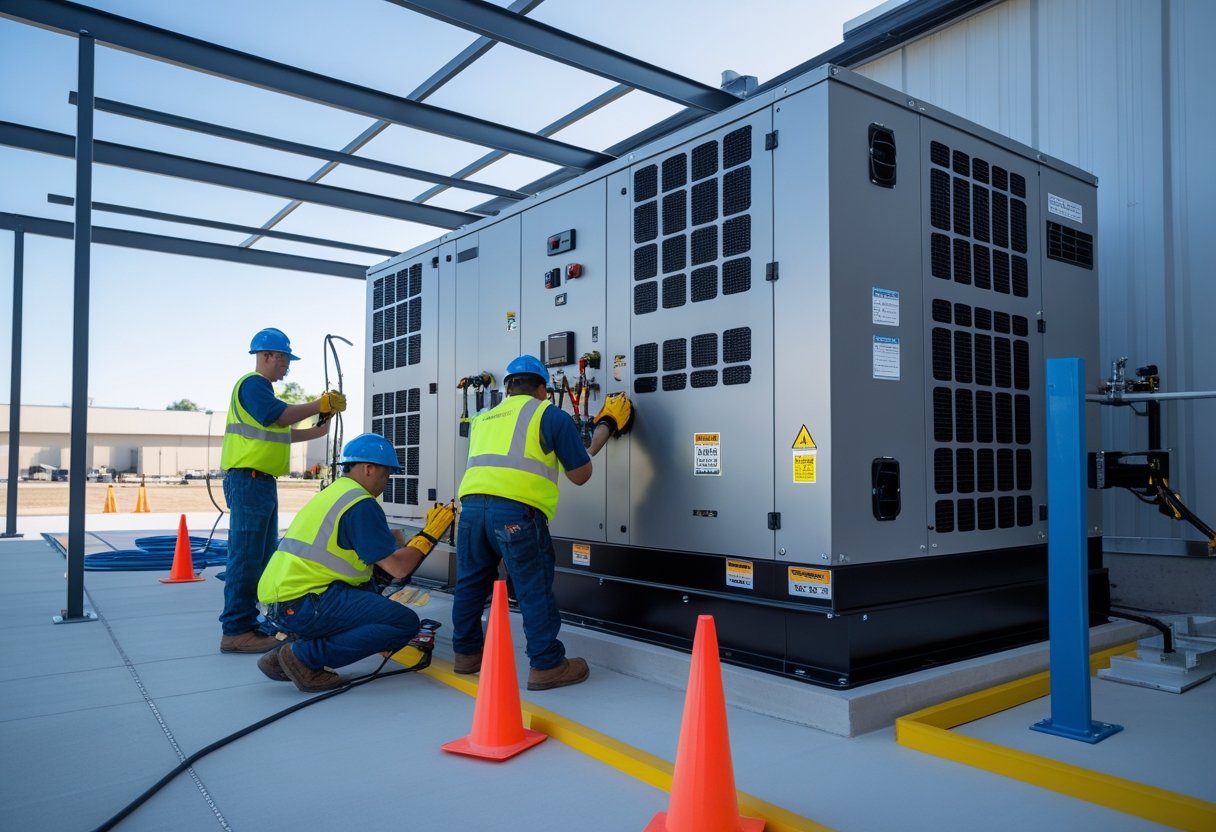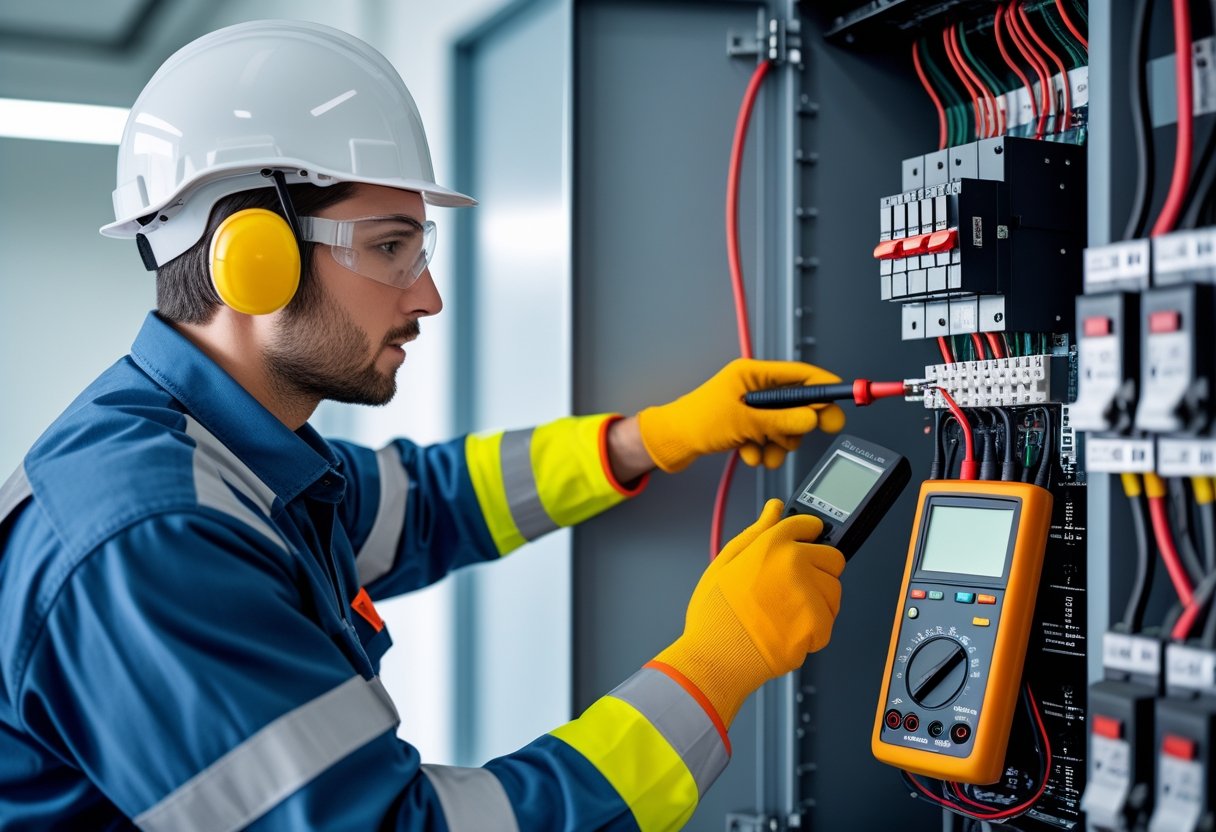If you've ever experienced the frustration of your circuit breaker tripping repeatedly, you're not alone. Many homeowners encounter this issue, often wondering why it happens and what they can do about it. A tripping circuit breaker is typically caused by an overload in the electrical system, a short circuit, or a ground fault, which can compromise your home's safety. Ignoring the problem can lead to electrical fires or damage to your appliances, making it essential to address the issue promptly.
Understanding the root causes can be a vital first step towards a solution. At AAA Electrical Services, we know that safety is your top priority, which is why our licensed professionals focus on tailored electrical services designed with your family's safety in mind. Whether it's malfunctioning appliances or an outdated panel, there are straightforward ways to diagnose and fix the problem before it escalates.
If you find yourself regularly resetting your breaker, don’t hesitate to seek expert help. With more than 42 years of experience serving the Sacramento area and surrounding towns, AAA Electrical Services is equipped to provide same-day solutions that restore your peace of mind quickly and efficiently.
How Circuit Breakers Function
Understanding how circuit breakers function is essential for maintaining a safe electrical system in your home. This section covers the purpose of circuit breakers, their basic operation, and the key components that make them work effectively.
Purpose of Circuit Breakers
Circuit breakers act as safety devices within your home's electrical system. Their primary role is to prevent electrical overloads and short circuits. When too much electrical current flows through a circuit, the breaker automatically disconnects the power, protecting both your home and its occupants.
By halting the flow of electricity, circuit breakers reduce the risk of fires and damage to appliances. Regular maintenance and timely repairs are crucial for ensuring these devices operate effectively. If you encounter persistent issues, engaging a professional service like AAA Electrical Services can help diagnose and resolve problems swiftly.
Basic Operation
A circuit breaker operates using a mechanical switch that is sensitive to electrical current. When current exceeds a predetermined level, the mechanism trips and opens the circuit. This interruption stops the flow of electricity, preventing potential hazards.
There are two main types of operation: thermal and magnetic. Thermal breakers use heat to detect overloads, while magnetic breakers respond to short circuits instantly. Understanding these mechanisms can help you recognize when a breaker is functioning correctly or may require professional attention.
Key Components
Circuit breakers consist of several key components that work together to ensure safety and reliability. These include:
- Interruption Mechanism: This is the actual switch that opens the circuit during overloads.
- Contacts: These metal parts close the circuit under normal conditions and open it when tripped.
- Relay Mechanism: This detects the current flow and triggers the interruption mechanism.
Proper installation and maintenance of these components are vital for the efficient operation of the breaker panel. If you're unsure about the state of your circuit breakers, AAA Electrical Services offers expert inspections and repairs to keep your electrical system safe and functional.
Common Reasons Circuit Breakers Trip
Understanding why circuit breakers trip can help you address electrical issues effectively. The following factors often contribute to a tripping circuit breaker: overloaded circuits, short circuits, ground faults, and faulty appliances. Each has specific signs and solutions that are crucial for safety in your home.
Overloaded Circuits
An overloaded circuit occurs when too many devices draw power from a single circuit. This typically happens when high-wattage appliances or multiple devices are used simultaneously. You may notice lights flickering or other devices losing power.
To prevent overloads, you can redistribute electrical devices across multiple circuits. Identify which devices are causing the overload and consider unplugging some or using a power strip with built-in circuit protection. If issues persist, a professional, like AAA Electrical Services, can assess your home’s circuitry for necessary upgrades.
Short Circuits
A short circuit happens when electricity flows along an unintended path, often because of damaged wiring or loose connections. This can create sparks or burning smells, and it frequently causes the circuit breaker to trip.
If you suspect a short circuit, it's essential to identify the source immediately. Inspect outlets and cords for any visible damage. It’s best to call an electrician to diagnose and repair the issue, ensuring your home remains safe and free from electrical hazards.
Ground Faults
Ground faults occur when electrical current escapes its intended path and touches the ground, often through moisture or damage. These are particularly common in areas like bathrooms or kitchens where water is present.
Ground fault circuit interrupters (GFCIs) can help prevent problems, as they automatically shut off power when a fault is detected. If a GFCI trips frequently, there may be an underlying issue that needs addressing. Consult with a skilled technician to evaluate and resolve the situation.
Faulty Appliances
Faulty appliances can also trigger circuit breakers. When an appliance is damaged or malfunctioning, it may draw excessive current, leading to a tripped circuit breaker. Signs include unusual noises, burning smells, or appliances that turn off unexpectedly.
To address this, disconnect the appliance from power and check it for visible issues. If the problem persists after troubleshooting, it’s wise to seek help from a qualified electrician. AAA Electrical Services provides reliable appliance diagnostics to ensure your home’s safety.
Diagnosing Frequent Tripping
Frequent tripping of your circuit breaker can indicate underlying electrical issues in your home. Identifying the affected circuit, checking for faulty wiring, and recognizing damaged components are essential steps to diagnosing the problem.
Identifying the Affected Circuit
Start by determining which circuit is tripping frequently. Take note of the devices or appliances connected to this circuit. If specific equipment seems to strain the circuit, it may reveal an overload.
Using a labeled circuit breaker panel can help identify which area of your home is affected. Pay attention to times when the breaker trips. If it happens during specific high-demand activities, it points to a possible circuit overload. If it’s unclear, you may need help from professionals like AAA Electrical Services.
Checking for Faulty Wiring
Inspect the wiring for any visible signs of wear, such as scorch marks or exposed wires. Faulty wiring is a common cause of circuit breaker issues and can lead to more serious problems like electrical fires.
Look for damaged wiring, especially at connection points and junction boxes. Ensure that all plugs and outlets are in good condition and not overheating. If there's any doubt, a qualified technician can help. AAA Electrical Services specializes in this type of assessment and can ensure your home’s safety.
Recognizing Damaged Components
Electrical components such as outlets, switches, and circuit breakers themselves can fail over time. Inspect these components for signs of damage, like charring or melting plastic, which can indicate overheating.
If an outlet feels warm or shows discoloration, it may need replacement. Older breakers may weaken and trip more frequently, even when circuits are not overloaded. If you notice persistent issues, consider consulting a licensed electrician to evaluate and replace damaged components efficiently.
Steps to Safely Troubleshoot the Problem
When your circuit breaker keeps tripping, it’s essential to address the issue safely and effectively. By following a few key steps, you can troubleshoot the problem and determine if it’s a simple DIY fix or something that requires professional assistance.
How to Reset a Tripped Breaker
To reset a tripped breaker, begin by locating your electrical panel. Open the panel door and identify the breaker switch that is in the "off" position. Flip the switch firmly back to the "on" position. If the breaker immediately trips again, it indicates a potential issue. Avoid repeatedly resetting the breaker, as this can pose an electrical hazard and may lead to a fire hazard.
Always ensure your hands are dry, and do not touch any wires or exposed components. If the breaker repeatedly trips after resetting, it’s advisable to stop and investigate further before using the circuit again.
Basic DIY Fixes
There are a few basic DIY fixes you can try. Start by checking for overloaded circuits. If too many devices are running on a single circuit, unplug some devices to see if that resolves the issue. Inspect your cords and appliances for any visible signs of damage or fraying that could cause shorts.
You can also try tightening any loose connections in the outlets or switches on that circuit. Remember, all repairs should prioritize electrical safety. If you are unsure about any step, it is always best to contact a professional, like AAA Electrical Services, for guidance.
Signs to Call an Electrician
If the breaker continues to trip after your troubleshooting, consider reaching out to an electrician. Signs that you should call an expert include:
- Frequent tripping even after unplugging devices.
- Burnt smells or unusual noises coming from the panel.
- Any signs of smoke, sparking, or warmth around the breaker or outlets.
These could indicate serious issues that require immediate attention. Don’t risk electrical shock or further damage; it's best to have trained professionals assess the situation. AAA Electrical Services is ready to help you with any electrical repairs needed.
Preventing Circuit Breaker Tripping in the Future
To minimize the risk of circuit breaker tripping, focus on updating outdated wiring, utilizing GFCI outlets and surge protectors, and ensuring regular maintenance. Addressing these critical factors promotes a safer electrical environment and enhances the reliability of your home's electrical system.
Upgrading Outdated Wiring
Outdated wiring can lead to overheating and increased risk of circuit breaker trips. If your home has old wiring, consider upgrading to modern standards. This may involve replacing faulty circuits and ensuring compliance with current electrical codes. Consult professionals at AAA Electrical Services for an assessment and necessary upgrades. Modern wiring improves flow and safety, reducing the likelihood of overload and tripping.
Installing GFCI Outlets and Surge Protectors
GFCI outlets are essential in areas prone to moisture, such as kitchens and bathrooms. They provide protection by shutting off power when an electrical imbalance is detected. Installing these outlets can significantly reduce the chances of tripping. Surge protectors offer an extra layer of defense by safeguarding your appliances from voltage spikes. They are especially important for sensitive electronics. Including both in your home’s electrical setup will help prevent unexpected outages.
Regular Maintenance and Inspections
Regular maintenance of your electrical system is crucial for long-term reliability. Schedule periodic inspections to identify potential issues before they escalate. This includes checking circuit breakers, outlets, and wiring for wear. Professionals at AAA Electrical Services provide thorough inspections that ensure everything is functioning correctly. Proactive maintenance can save you from frequent inconveniences and enhance the lifespan of your electrical components.
When to Consult a Professional Electrician
When you experience frequent tripping of your circuit breaker, it’s crucial to assess the situation carefully. Certain signs indicate that it's time to reach out to a professional electrician for help. This is especially important for addressing safety concerns and ensuring your home's electrical system operates effectively.
Certified vs. Licensed Electricians
It's essential to understand the distinctions between certified and licensed electricians. A licensed electrician has completed the required education and passed examinations mandated by local authorities, which reflects a comprehensive understanding of electrical systems. Alternatively, a certified electrician may have specialized skills or training, such as in renewable energy or residential wiring.
Always opt for electricians with relevant credentials. This ensures they possess the knowledge to address issues related to faulty breakers or bad circuit breakers. When hiring, verify their insurance and background checks—this protects you and your home during repairs.
Risks of Ignoring Electrical Problems
Ignoring persistent electrical issues, like a circuit breaker that frequently trips, can lead to severe risks. For instance, power surges can damage your appliances and lead to costly replacements. More critical, however, is the potential for arc flash, which can cause electrical fires or serious injuries.
Addressing electrical problems promptly is not just about convenience; it’s about safety. If you notice unusual buzzing sounds, burnt smells, or visible damage to outlets, consult with a qualified electrician promptly. By doing so, you can prevent minor issues from escalating into major hazards.
Ensuring Electrical Power Safety
Ensuring your home's electrical system operates safely is paramount. Regular inspections of your breaker panel and wiring can help identify potential weaknesses before they become problematic. This proactive approach not only enhances safety but can also improve the efficiency of your home’s electrical power.
If your circuit breaker is malfunctioning or has to be reset frequently, don’t hesitate to contact a professional. AAA Electrical Services specializes in circuit breaker repair and installation, ensuring that your home remains safe and functional. Remember, in the Sacramento area and beyond, having a trusted expert can provide peace of mind knowing your family's safety is prioritized.
Frequently Asked Questions
Understanding the reasons behind a circuit breaker tripping can help you address the issue effectively. Here are some common questions related to circuit breakers and their potential problems.
Is it dangerous if a circuit breaker frequently trips?
Yes, frequent tripping can indicate a potentially dangerous electrical issue. It often means there is an overload or a short circuit, which can lead to electrical fires. If this occurs, it’s essential to consult a professional, like those at AAA Electrical Services, to ensure your home’s safety.
What could cause a breaker to trip with no load attached?
A breaker may trip even with no load due to a ground fault or a short circuit. Old or damaged wiring can also cause this issue. Regular inspections can help identify these risks before they escalate.
How can I determine what causes my breaker to trip when I plug an appliance in?
To identify the cause, plug in one appliance at a time to see which one triggers the trip. This method can help isolate faulty appliances. If multiple appliances cause the breaker to trip, the issue may lie with the circuit itself.
What steps should I take to identify the cause of a circuit breaker tripping?
Start by checking for overloaded circuits or faulty appliances. Inspect outlets and plugs for signs of damage. If the problem persists, consider contacting AAA Electrical Services for professional help in pinpointing the issue.
What should I do if my circuit breaker won't stay reset?
If your breaker won't stay reset, it may indicate a more significant problem, such as a short circuit or a faulty breaker. Avoid continuous resetting; instead, seek help from a licensed technician to diagnose and resolve the issue.
What are common reasons for a circuit breaker to suddenly start tripping?
Common reasons include circuit overloads, short circuits, ground faults, or issues with connected devices. Environmental factors, such as moisture in outlets, can also contribute. Addressing these problems early can help maintain a safe electrical system.





